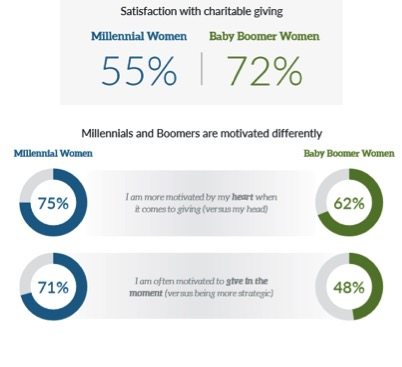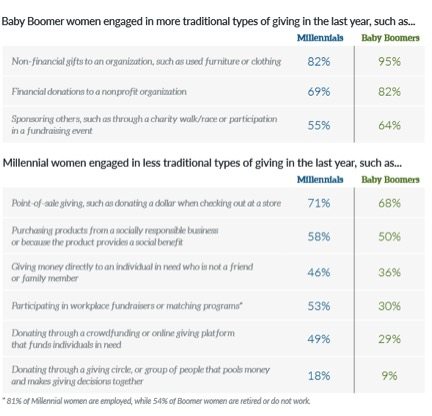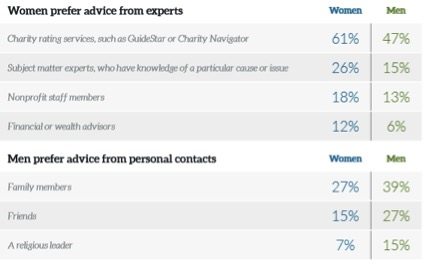
Fidelity Charitable, the largest collection of donor-advised funds in the United States, released its Women and Giving report this week, which examines giving attitudes, strategies, and priorities across generations and gender. We are left with many questions about this report’s value to those raising funds for their own particular causes.
Before we delve into the findings, it is worth noting that the survey sample includes only those who itemized giving on their tax returns in 2015. We would hate to think that donors were being approached differently based on this information, but you can make up your own minds; we’re just here to pass the information along.
The study is full of charts that exhibit the differences between women and men and between women from the Millennial and Baby Boomer generations:

The question we’re left with on this one is, “So what?” question on that one. Maybe we become more strategically minded as we age, or maybe we just have more time on our hands to sit around and ruminate. This stuff is something of a moving target, so who knows? And, how do we know that developing new development strategies that play to these differences wouldn’t cause more unintended consequences than benefits?
On the other hand, knowing the differences in the pathways for giving between generations may be of some use. One or two conclusions sparked questions for us—like the marked difference in participation in workplace giving programs, which looks opposite to what we might have guessed.

Sign up for our free newsletters
Subscribe to NPQ's newsletters to have our top stories delivered directly to your inbox.
By signing up, you agree to our privacy policy and terms of use, and to receive messages from NPQ and our partners.
What else does the study suggest? Baby Boomer and Millennial women take their giving seriously, viewing it as a part of their identity and seeking to solve societal changes. Millennial women tend to be more inclusive in their giving. Fifty-five percent of Millennial women report supporting a number of causes, while 67 percent of Boomer women report supporting a limited number of causes. For both, access to nutritious food and health services tops their list of issues. Millennial women also support environmental efforts, “have a greater focus on expanding opportunities for women and girls,” and are “more likely than Boomer women to split their focus between international and domestic issues.”
According to the report, both Boomer and Millennial women create emotional connections to the causes they support, in contrast to men, who are “more influenced by strategy,” at least as regards the tax benefits of giving. This notion of men being more strategic givers, however, doesn’t seem to be supported elsewhere in the findings.
For instance, assuming that information is useful in being strategic, what do we make of the fact that both generational groups of women prefer advice from experts in making charitable investment decisions, while men prefer advice from personal contacts?

Elsewhere, the report finds that Millennial men in particular are “less prepared to navigate many of the strategic and interpersonal aspects of giving.” Though they identify causes that are important to them, they report feeling social pressure from friends and family in the form of requests for support of their preferred causes. They are also less willing to disappoint charities they have given to for years. Hmmm…where’s that strategy now?
In terms of leverage, Millennial women socialize their giving, encouraging their networks (50 percent) and influencing the men in their family (46 percent) to support their causes. Meanwhile, 70 percent of Boomer women do not talk about the organizations they support.
So, in the end, what are our takeaways as fundraisers? We don’t see much, with the very notable exception of a renewed understanding that younger women see their role as philanthropic agents more than individual philanthropic givers, which is in and of itself a model we should support in every supporter. But, maybe you see more! Please share!













